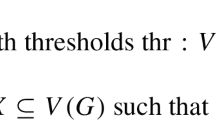Abstract
In this paper we consider a fundamental problem in the area of viral marketing, called Target Set Selection problem. We study the problem when the underlying graph is a block-cactus graph, a chordal graph or a Hamming graph. We show that if G is a block-cactus graph, then the Target Set Selection problem can be solved in linear time, which generalizes Chen’s result (Discrete Math. 23:1400–1415, 2009) for trees, and the time complexity is much better than the algorithm in Ben-Zwi et al. (Discrete Optim., 2010) (for bounded treewidth graphs) when restricted to block-cactus graphs. We show that if the underlying graph G is a chordal graph with thresholds θ(v)≤2 for each vertex v in G, then the problem can be solved in linear time. For a Hamming graph G having thresholds θ(v)=2 for each vertex v of G, we precisely determine an optimal target set S for (G,θ). These results partially answer an open problem raised by Dreyer and Roberts (Discrete Appl. Math. 157:1615–1627, 2009).
Similar content being viewed by others
References
Ben-Zwi O, Hermelin D, Lokshtanov D, Newman I (2010) Treewidth governs the complexity of target set selection. Discrete Optim. doi:10.1016/j.disopt.2010.09.007
Chen N (2009) On the approximability of influence in social networks. SIAM J Discrete Math 23:1400–1415
Dreyer Jr PA, Roberts FS (2009) Irreversible k-threshold processes: graph-theoretical threshold models of the spread of disease and of opinion. Discrete Appl Math 157:1615–1627
Dirac GA (1961) On rigid circuit graphs. Abh Math Semin Univ Hamb 25:71–76
Domingos P, Richardson M (2001) Mining the network value of customers. In: Proc 7th ACM KDD. ACM Press, New York, pp 57–66
Flocchini P, Lodi E, Luccio F, Pagli L, Santoro N (2004) Dynamic monopolies in tori. Discrete Appl Math 137:197–212
Fulkerson DR, Gross OA (1965) Incidence matrices and interval graphs. Pac J Math 15:835–855
Imrich W, Klavžar S (2000) Product graphs: structure and recognition. Wiley, New York
Kempe D, Kleinberg J, Tardos E (2003) Maximizing the spread of influence through a social network. In: Proc 9th ACM KDD. ACM Press, New York, pp 137–146
Peleg D (2002) Local majorities, coalitions and monopolies in graphs: a review. Theor Comput Sci 282:231–257
Rose DJ, Tarjan RE, Lueker GS (1976) Algorithmic aspects of vertex elimination on graphs. SIAM J Comput 5:266–283
Tarjan RE, Yannakakis M (1984) Simple linear-time algorithms to test chordality of graphs, test acyclicity of hypergraphs, and selectively reduce acyclic hypergraphs. SIAM J Comput 13:566–579
Acknowledgements
The authors would like to thank the anonymous referee for very careful reading and for many constructive suggestions which help to improve the presentation of this paper.
Author information
Authors and Affiliations
Corresponding author
Additional information
Second author is partially supported by National Science Council under grant NSC100-2811-M-008-052.
First and fourth authors are partially supported by National Science Council under grant NSC100-2115-M-008-007-MY2.
Rights and permissions
About this article
Cite this article
Chiang, CY., Huang, LH., Li, BJ. et al. Some results on the target set selection problem. J Comb Optim 25, 702–715 (2013). https://doi.org/10.1007/s10878-012-9518-3
Published:
Issue Date:
DOI: https://doi.org/10.1007/s10878-012-9518-3




